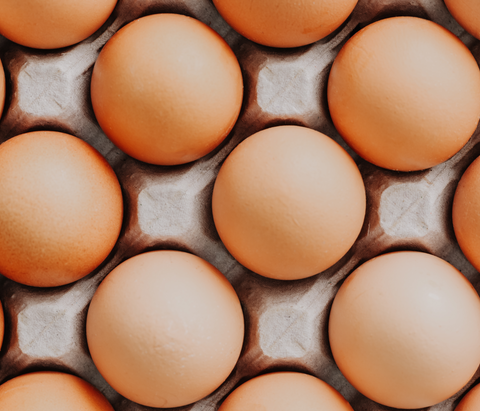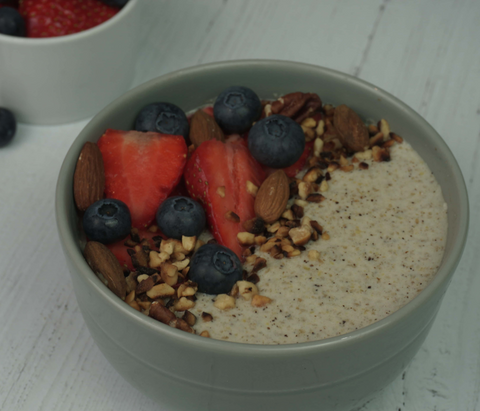Whilst eggs are healthy and versatile, many people choose to avoid eggs. Whether you’re vegan or eggs just don’t agree with you, there are plenty of egg replacers perfect for cooking or baking. Following a keto or low-carb diet and not eating eggs is an even larger can of worms! Luckily, we’ll be covering all things keto-friendly egg replacers - how to make them, which are best and how keto-friendly they are!
Eggs: The Basics
Eggs are used in cakes, meringues, cookies, brownies, pancakes - the list goes on! Eggs are in many baking recipes for a reason - their role is to thicken, build volume, stabilise, emulsify and provide distinct flavours. We can reduce this into three key roles:
- Moisture - Provide and maintain moisture in a mixture
- Structure/binding - Helps a mixture stay bound together and hold its shape
- Leavening - Helps a mixture rise
Eggs can have one or all of these roles in a recipe, it all just depends on the other ingredients and what gap needs to be filled in order to get to that baked treat. Most bakes like cakes or cookies need eggs for a similar reason.
Using a good egg replacer depends on why the egg is needed in the recipe. In other words, make sure you’re using a substitute that fulfils the egg’s role. For example, cakes tend to need an agent that provides moisture, structure and leavening. So you’ll need an egg replacer that ticks all of these boxes. We’ll get on to discussing the role of each egg replacer and which bake it’s best for below!
Let’s crack on with discussing egg replacers, in order of most to the least recommended options.
Flax Seed Eggs

Flax eggs are the perfect egg substitutes to help mixtures bind together. Flax eggs can be made with the bog-standard flax seed meal, which will add an earthy flavour to your bakes. If you want a more neutral, subtle flavour, then we recommend using golden flaxseed meal.
How to Make Flax Eggs
The perfect ratio is important to make your flax seeds eggy. To make one ‘egg’, you’ll need a 1:3 ratio of flaxseeds to water. In other words:
1 egg = 1 tbsp of flax meal : 3 tbsp of water
From here on out, it’s a pretty easy process!
- Whisk together the flax seed meal and water.
- Refrigerate the mixture for at least 15 minutes. This will let the watery mixture get thicker.
- All done! Add to any recipe requiring regular eggs.
Flax eggs will last 1-2 days in the fridge, or you can freeze them for 3-4 months.
How Keto-Friendly are flax eggs?
Difference in nutritional value to eggs:
Large chicken egg: 77 calories, 0.6g net carbs
Flax egg: 55 calories, 0.2g net carbs
You read that right, with these flax eggs you have a bit more wiggle room with your daily carb intake!
Don’t Use Flax Eggs When Making:
- Recipes that need whipped egg whites for structure, such as soufflés.
- Flourless recipes - you need some form of flour-like ingredients in the recipe to enable the flax seeds to bind the dry ingredients.
- Dishes with actual eggs as the main ingredient, including a frittata or omelette.
- Light and airy bakes that need eggs to do more than just bind ingredients - flax eggs can make things like cakes and pancakes dense as they don’t act as a leavening agent.
When to Use Flax Eggs
All in all, flax seeds work well for binding, though they get a bit of stage fright pretending to be the star of the show. Feel free to use them in denser bakes such as keto cookies or brownies! If there are other ingredients in the recipe that act as leaveners, then you can go ahead and replace all eggs with flax seeds.
Chia Seeds

Chia seed eggs are similar to flax eggs, with the only difference being that they contain chia seeds. The texture, appearance and net carbs of chia eggs also differ from flax eggs.
How to Make Chia Eggs
To make chia eggs, you can use the exact same ratio as flax seed eggs.
1 egg = 1 tbsp of chia seeds : 3 tbsp of water
Use the same method as flax eggs and be sure to let this mixture sit for around 5-15 minutes to let the mixture thicken.
Don’t like the texture of Chia seeds? Well you won’t feel the texture of chia when only substituting one or two eggs. But if you don’t like the small seeds showing up in your dishes then you can grind them before adding to water.
How Keto-Friendly are Chia Eggs?
Here’s the difference in nutritional value to eggs:
Large chicken egg: 77 calories, 0.6g net carbs
Chia egg: 58 calories, 0.8g net carbs
Yes chia eggs have slightly more net carbs then actual eggs and flax eggs, which is why they’re less recommended than flax eggs but are still a keto-friendly option!
Don’t Use Chia Eggs When Making:
- Any recipes that require more than 3 eggs, as your recipe might become a little too chia heavy! The multiple chia eggs will do more than just bind and you’ll feel the texture of chia.
- Dishes with actual eggs as the main ingredient, including scrambled eggs or meringues.
- Light and airy bakes that need eggs to do more than just bind ingredients - chia eggs can make things like cakes and pancakes dense as they don’t act as a leavening agent.
When to Use Chia Eggs
You can confidently substitute all eggs for chia eggs when baking denser treats such as brownies, cookies or muffins. If you’re baking lighter treats like cakes or pancakes and there are other ingredients in your recipe that act as leaveners, then you can go ahead and use chia eggs. Does the recipe lack a leavener? Combine your own leavening substitute with chia eggs! You can even add a little bit of baking powder and soda to help your pancakes rise!
Worried that other people won’t be fond of the appearance or texture of chia in your baked treats? To keep your dishes less chia-y, we recommend using chia eggs as substitutes in recipes that require no more than two eggs. You can even disguise the appearance of chia seeds by darkening your baking mixture with some cocoa powder!
Baking Soda & Vinegar

Baking Soda & Vinegar is a great leavening agent with ingredients you most definitely have laying around in your kitchen cupboards!
How to Make Baking Soda & Vinegar Eggs
To make this egg substitute, you can use either white distilled vinegar or apple cider vinegar.
1 egg = 1 teaspoon of baking soda + 1 tablespoon of vinegar
All you have to do is just mix the ingredients in a small bowl. These ingredients cause a reaction that creates carbon dioxide and water, which is great for making baked treats light and fluffy!
How Keto-friendly are Baking Soda & Vinegar Eggs?
1 tbsp of white distilled vinegar has 0g of net carbs and 1 tbsp of apple cider vinegar has around 0 to 1g of net carbs, depending on which one you buy. Baking soda is also free of net carbs! So, let’s compare properly:
Baking soda & Vinegar egg: 0 calories, 0g - 1g net carbs
Large chicken egg: 77 calories, 0.6g net carbs
Using this egg substitute is a great low-calorie, low-carb option. The exact nutritional information will vary from brand to brand, so make sure to double check the bottle of vinegar you’re using.
Don’t Use Baking Soda & Vinegar When Making:
- Recipes with actual eggs as the main ingredient or include just egg whites, including scrambled eggs or meringues.
- Mixtures that need eggs to do more than just make your baked goods light and fluffy.
- Recipes that require more than two eggs. Be sure to only use this substitute to replace one or two eggs, as having more than two tablespoons of vinegar regularly can lead to side effects such as tooth enamel erosion from all the acidity.
When to Use Baking Soda & Vinegar
Baking soda & Vinegar is a versatile egg substitute that is perfect for delicate bakes because of its subtle flavour and lifting power! Use Baking Soda & Vinegar as an egg substitute when baking cakes, bread or cupcakes.
We recommend using baking soda & vinegar instead of eggs when baking cakes or cupcakes. A vinegar-y flavour shouldn’t come through your bakes, but just to be safe, stick to using this substitute in larger mixtures - or at least mixtures with more than three ingredients. The bubbly reaction that gives your bakes that lovely airy & light texture won’t last long, so be quick to put your mixtures straight in the oven!
Greek Yoghurt

Yoghurt can mimic the moisture provided by eggs, acting is an easy egg replacer to help complete many baking ventures. Here’s the straightforward recipe:
1 egg = ¼ cup of yoghurt
Simply dump in the yoghurt to your mixture and you’re good to go! Remember that a plain yoghurt will work better than flavoured as it won’t change the flavour of your recipe.
How Keto-friendly is Greek Yoghurt?
We recommend using full-fat Greek yoghurt to make sure you’re getting the highest fat content. Simply check nutritional information to double check that there isn’t a diet-threatening amount of carbs. You can make life easier by opting for keto-friendly brands as net carbs can vary between products. Here is the nutritional information for one Greek yoghurt egg when using a ¼ cup of plain whole milk Greek yoghurt:
Greek yoghurt egg: 31 calories, 1.28g net carbs
Large chicken egg: 77 calories, 0.6g net carbs
As you can see, the net carbs of Greek yoghurt is higher than a large chicken egg. Whilst this isn’t a huge red flag, it does mean that you have to be careful with how many eggs you’re substituting. Also remember that nutritional information and net carbs will vary from brand to brand, so take some time to find the Greek yoghurt with little to no added sugar. We recommend choosing whole milk, plain Greek yoghurt, or find a keto yoghurt that contains keto-friendly sweeteners.
Don’t Use Greek Yoghurt When Making:
- Dishes with actual eggs as the main ingredient or include just egg whites, including scrambled eggs or meringues.
- Baking mixtures that require eggs to act as a leavener or binder. Greek yoghurt is best for adding moisture only!
When to Use Greek Yoghurt
Greek yoghurt is perfect for providing moisture to recipes including cakes and muffins. You can replace all eggs with greek yoghurt if there are other ingredients in the recipe that act as leaveners or binders. Otherwise, use both yoghurt and one other binding or leavening substitute mentioned in this blog!
All in all, Greek yoghurt is very versatile and a keto kitchen stable. If you have any left over, serve your cake with a dollop of greek yoghurt!
Aquafaba

Ever cooked legumes and beans and had a ton of liquid left over? Well that liquid is called Aquafaba and you can use it to replace eggs! It’s the same liquid you’ll find in canned chickpeas or beans. The consistency of aquafaba has a similar consistency to raw egg whites, so it makes sense that this is a common vegan substitute for eggs.
How to Make Aquafaba Eggs
Aquafaba is a great leavening agent that can replace egg whites. It can also act as a binder to replace whole eggs. You can easily replace eggs with aquafaba by sticking to the following ratio:
1 large egg white = 2 tablespoons of aquafaba
1 large whole egg = 3 tablespoons of aquafaba
A can of chickpeas should be plenty to replace a few eggs, as a can yields around 12 tablespoons of aquafaba.
When using aquafaba as a binder, aka. to replace a whole egg, you can use aquafaba straight out the tin. It is also okay to slightly whip the liquid until foamy - do not properly whip them like egg whites.
If you’re replacing an egg white, you’ll have to properly whip the aquafaba for between 10 to 15 minutes. You can add ¼ teaspoon of cream of tartar or lemon juice before you start whipping to help the liquid foam up, enabling the aquafaba to whip easier and produce a more stabilised result. It should end up looking similar to the consistency of egg whites. If it seems too watery, then you can thicken up the mixture by simmering it in a pan on low heat until it’s reduced by about 25%.
Aquafaba straight out the tin can be refrigerated for a couple days, though freezing it in cubes is best to help it last much longer.
How Keto-friendly is Aquafaba?
Aquafaba egg: 8 - 15 calories, 1.3g net carbs
Large chicken egg: 77 calories, 0.6g net carbs
Whilst Aquafaba has higher net carbs compared to eggs, it’s not a significant jump and you can easily substitute a couple eggs whilst keeping track of your macros.
Don’t Use Aquafaba When Making:
- In recipes requiring both egg yolk & egg white. As whipped aquafaba mimics egg whites, stick to using aquafaba in recipes that call for just egg whites.
- In recipes where eggs are meant to do more than what aquafaba signed up for! Plain aquafaba is simply a binder, so won’t do much for leavening or adding moisture. Don’t use unwhipped aquafaba where it is needed as a leavener or to provide moisture.
- Dishes that require actual eggs as the main ingredient, including scrambled eggs or meringues.
When to Use Aquafaba
Unwhipped, aquafaba can work as a binder when baking treats such as cookies or pancakes. The thickness of aquafaba varies across brands, with some being thin and runny and others gelatinous and goopy. When you’re trying to use aquafaba as a binder, it’s best to use the thick and goopy variety!
When whipped into semi-soft peaks, aquafaba is a great whipped egg white substitute - feel free to add this to any recipe calling for whipped egg whites, including marshmallows, meringues or macaroons.
Let’s Crack On
Now you know some of the most tried & tested egg replacers out there. Depending on your daily net carb goals, baking adventures and what’s laying around in your kitchen cupboards, take your egg replacement pick! When shopping for any of these ingredients be sure to look out for nutritional information and opt for unflavoured options. Which are you going to try first? Or have you already tried a keto-friendly egg replacer at home? Let us know your experiences down below!




Comments (0)
There are no comments for this article. Be the first one to leave a message!